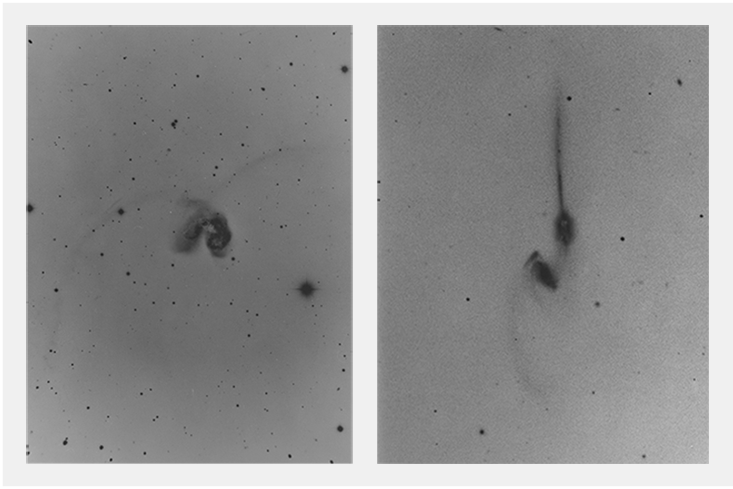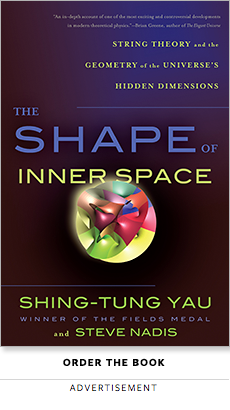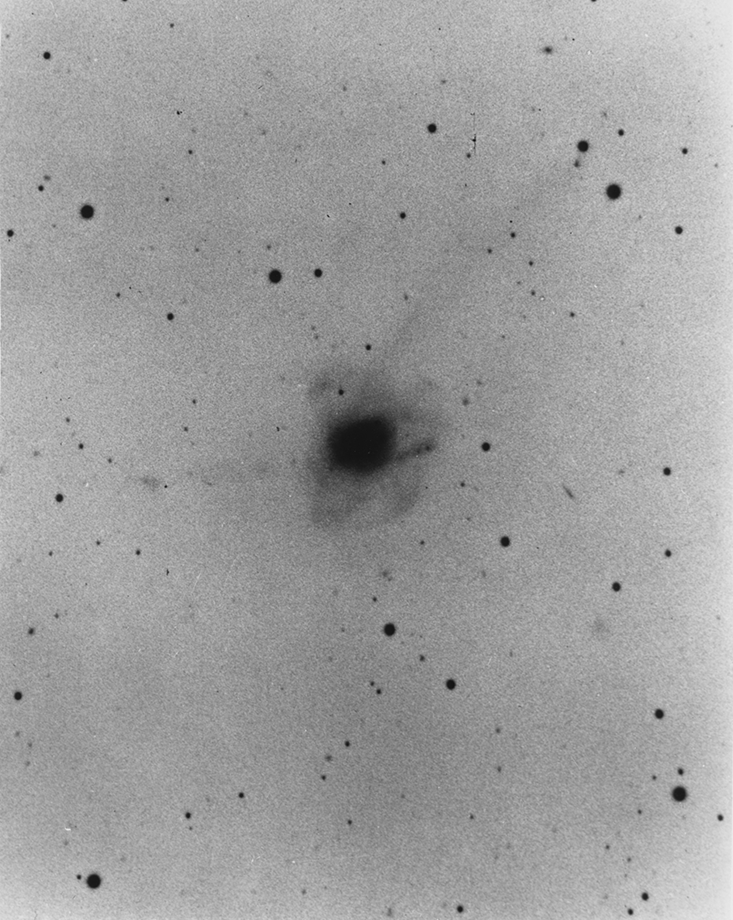The biggest merger to ever hit these parts is coming—a union that promises to be more tumultuous than that of Richard Burton and Elizabeth Taylor, offer more star power than Brangelina, and deliver more jet propulsion than the new American Airlines–US Airways conglomerate. We’re talking about the coming together of the Milky Way galaxy and its nearest large neighbor, Andromeda, in a collision that scientists now deem inevitable. This celestial amalgamation will begin in about 4 billion years and finish within another 2 billion, producing a new, larger elliptical galaxy in place of the two spirals that originally conjoined.
Mergers are routine rites of passage for galaxies. “All of the biggest and best studied galaxies around us today are either currently interacting galaxies or collisions waiting to happen,” says Roeland van der Marel of the Space Telescope Science Institute. “And this is happening all over the place.” In fact, the Milky Way is already in the midst of a smaller-scale merger: Anywhere from 100 million to a billion stars from the dwarf galaxy Sagittarius are falling into our galaxy right now.
But just 40 years ago, the very idea that galaxies could merge was scorned, and the shapes of post-merger galaxies were dismissed as sideshow curiosities—members of some bizarre menagerie of little import. Most astronomers regarded galaxies as “island universes” that formed in isolation and stayed that way. The story of how this assumption was changed starts with some weird-looking galaxies and two brothers who followed their curiosity.

One of those brothers, Alar Toomre, is now an emeritus professor of applied mathematics at the Massachusetts Institute of Technology (MIT). At 6’3” and 235 pounds with a prominent dome on top, the 77-year-old Toomre is, by his own admission, “ominously large.” This impression is softened, though, by a genial manner and a nonstop delivery of humorous quips that—in an alternate universe—might have landed him a job in a comedy club. Born in Estonia, Toomre earned his Ph.D. in fluid dynamics and assumed that he’d work for Boeing or NACA (NASA’s predecessor). Instead, he ended up teaching at his undergraduate alma mater, MIT, where his research took an unexpected turn.
Toomre became entranced by galaxies in the mid-60s after noticing that our galaxy is strangely warped. At the time, he wondered whether the Large Magellanic Cloud (LMC)—a nearby galaxy one-hundredth the size of the Milky Way—“might have come by and done us some damage.” But his calculations showed that such a close passage would have stretched the outer arms of the Milky Way until they resembled strands of taffy. He quickly realized that he was wrong, because our galaxy doesn’t look anything like that, but the conjecture led him to something else nevertheless.
The Milky Way is already in the midst of a smaller-scale merger.
A few months after completing that analysis, he went to Pasadena, spending the 1969-1970 academic year on sabbatical at the California Institute of Technology (Caltech). Although he could have used this opportunity to hobnob with eminent astronomers like Maarten Schmidt, the discoverer of quasars, Toomre was instead drawn to the more eccentric Halton Arp and his “inspiring” Atlas of Peculiar Galaxies, containing photographs of more than 300 unusually shaped assemblages of stars.
For Toomre, viewing the Atlas was uncanny, for he spotted many galaxies—including Arp 82 and Arp 87—with long, extended spiral arms, eerily reminiscent of the figure his simulated encounter of our galaxy with the LMC had produced. Other examples were even more spectacular. The “Mice” galaxies (Arp 242) consisted of two entangled galaxies that each resembled a rodent with an elongated tail. The “Antennae” (Arp 244) were another pair of intertwined galaxies, but they looked like an insect with two eyes and, most strikingly, two outsized antennae. Arp’s galaxies revealed other strange structures adorned with bright filaments and plumes, as well as “bridges” of stars connecting two galaxies.

Arp had collected the galaxy pictures to bolster unorthodox ideas he held about galaxy formation. Toomre, though, was drawn to these oddball galaxies in the same way that medical researchers look for out-of-the-ordinary diseases to improve their understanding of the human body. As he said in a 1987 interview, coming across a rare ailment was far more instructive for doctors than the usual aches and pains.
The Atlas strengthened his conviction that galaxies were not isolated islands, but social creatures that could be strongly influenced by their (gravitational) encounters with each other—in some instances blending together as one. He also suspected that interactions of this sort might be the rule rather than the exception. But he’d need more than a hunch to persuade a mostly skeptical scientific world.
 On returning to MIT, Toomre teamed up with his brother, Juri—an astrophysicist who was then based at the NASA Goddard Institute for Space Studies—to simulate galactic collisions on a computer. Fortunately, Juri had access to Goddard’s IBM “Stretch,” a room-sized mainframe that constituted the supercomputer of its era. However, the state-of-the-art at the time kept their simulations to a modest size, involving just 200 test particles. The brothers also needed to make the simplifying assumption that all of a galaxy’s mass resided in its center. After that, it was just a matter of applying the principles Isaac Newton had devised 300 years before. By knowing the force on a particle and its acceleration, he explained, you can determine its trajectory. Their calculations entailed no exotic physics—just elementary gravity. When galaxies collide, it’s not like an SUV ramming into a minivan. The stars within galaxies are so widely spaced that they don’t hit each other—they pull on each other. “The motion of any individual particle is not that remarkable,” Toomre observes. “What is amazing is the pattern that a bunch of particles can make.”
On returning to MIT, Toomre teamed up with his brother, Juri—an astrophysicist who was then based at the NASA Goddard Institute for Space Studies—to simulate galactic collisions on a computer. Fortunately, Juri had access to Goddard’s IBM “Stretch,” a room-sized mainframe that constituted the supercomputer of its era. However, the state-of-the-art at the time kept their simulations to a modest size, involving just 200 test particles. The brothers also needed to make the simplifying assumption that all of a galaxy’s mass resided in its center. After that, it was just a matter of applying the principles Isaac Newton had devised 300 years before. By knowing the force on a particle and its acceleration, he explained, you can determine its trajectory. Their calculations entailed no exotic physics—just elementary gravity. When galaxies collide, it’s not like an SUV ramming into a minivan. The stars within galaxies are so widely spaced that they don’t hit each other—they pull on each other. “The motion of any individual particle is not that remarkable,” Toomre observes. “What is amazing is the pattern that a bunch of particles can make.”
Galaxies were not isolated islands, but social creatures.
Among the astonishing patterns their simulations turned out were many of those seen in Arp’s celebrated Atlas, including the Antennae and Mice galaxies. For the Toomres, the implications were clear: Galaxies were constantly colliding into and distorting one another. The simulations not only explained the Atlas’s motley collection of shapes, but also the histories of regularly shaped galaxies. In particular, the brothers predicted that blob-like elliptical galaxies—which make up about 10 percent of all galaxies and whose bodies roughly resemble a sphere—can be produced through the melding of two, flat spiral galaxies.
Today, we know that such a galaxy will eventually result from the merger of the Milky Way with Andromeda. At the time, though, the Toomre brothers faced an uphill battle convincing the wider community of their ideas. To clinch the argument, it would take careful observations of yet another unusual galaxy—NGC 7252, or the so-called “Atoms for Peace” galaxy.

François Schweizer was a Berkeley graduate student in 1972 when the Toomres’ work was published, and it made an immediate impression on him. At California’s Palomar Observatory, and later at the Cerro Tololo Inter-American Observatory in the Chilean Andes, he explored the proposition that elliptical galaxies are the natural outcome of two spiral galaxies merging. After focusing on NGC 7252 for years, he found signs that the galaxy had just one nucleus but two distinct tails, thus betraying signs of a separate past that had not yet been totally erased. Interestingly, these two tails were moving independently, in opposite directions. “Two contrary motions within a single system had never been seen before.” Yet it was exactly what Toomre had predicted for a merger remnant. Schweizer’s paper on this subject, which was published in 1982, gained widespread acceptance. “It got a lot of people excited, leading to the research activity that persists to this day.”
Today, the list of galaxies that could be merger remnants has expanded to between 50 and 100, and there is evidence that thousands more are on the road to mergerdom. As for us? “Andromeda is coming toward us,” Toomre notes, and there’s no great mystery as to what will happen: The Milky Way will merge with its neighbor and become an elliptical. It’s just another example of the kind of problem—with a predictable, experimentally-documented outcome—that he and his brother worked out through simple calculations decades ago.
Steve Nadis, a writer based in Cambridge, Mass., is a contributing editor to Astronomy and Discover magazines. He is coauthor of A History in Sum: 150 Years of Mathematics at Harvard.


























